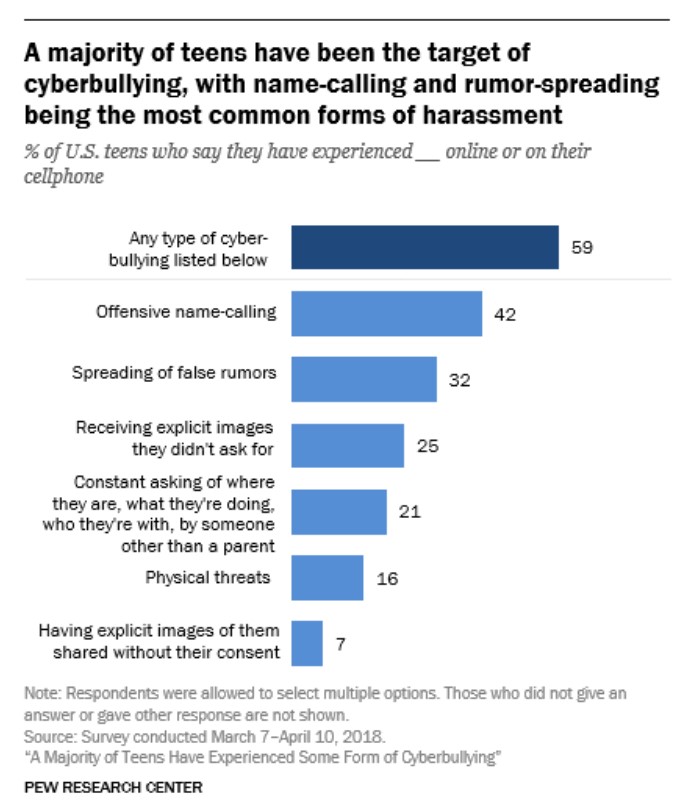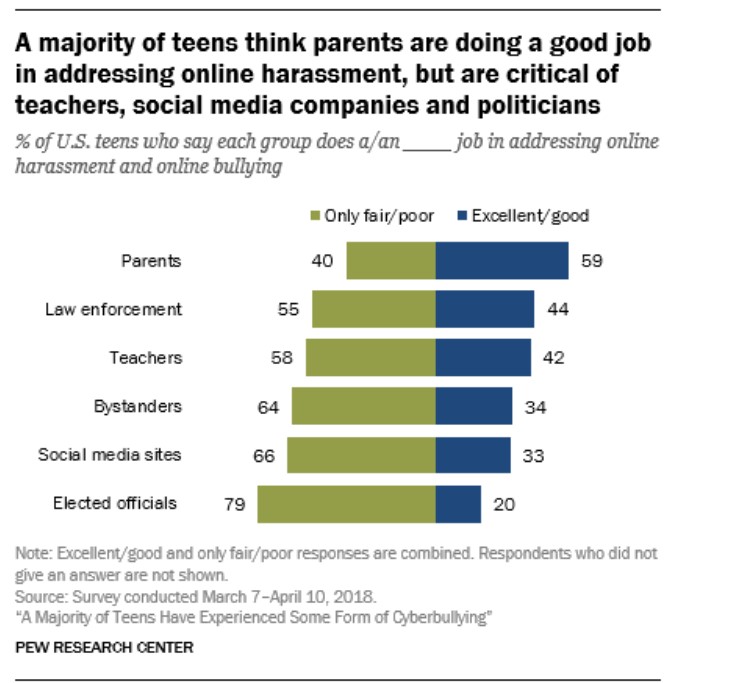
The headline of a recent Pew study says that “A majority of teens have experienced some form of cyberbullying.” In fact, 59% of the 743 teens questioned said that they had experienced at least one type of bullying behavior online or on their cell phone. As you can see from the chart below, the most common form of bullying, “offensive name calling” affected 42% of the teens. Next came “spreading of false rumors” at 32% followed by “receiving explicit images they didn’t ask for” at 25% About one in five said they experienced someone other than a parent constantly asking where they are, what they’re doing or who they’re with, while 16% received physical threats and 7% had explicit images shared of them without their permission.
The numbers are disturbing and — at first glance — in contradiction with data from other studies. For example, the National Center for Educational Statistics reported that 15.6% of students in grades 6-12 were “electronically bullied” in 2015, down from 16.2% in 2011. When it comes to high school students (grades 9 to 12), the Centers for Disease Control and Prevention Youth Risk Behavior Survey found that 14.5% of high school students were electronically bullied in 2017, compared to 19% who had been bullied in school, during the 12 months prior to the survey. That’s actually lower than it was in 2011 and 2015. It does appear that bullying tapers off with age. CDC reported that, in 2015, 24% of middle school students were cyberbullied and 45% were bullied on school property. The Cyberbullying Research Center has higher numbers than some studies but still lower then the Pew study. In a nationally representative sample of approximately 5,700 middle and high schoolers in the U.S., they found that 33.8 percent said they had been cyberbullied during their lifetime, while 16.9 percent said they had been cyberbullied within the previous 30 days. You’ll find more data as well as advice in ConnectSafely’s Parents Guide to Cyberbullying.
Definition of bullying
What is not clear from the Pew study is whether these numbers reflect the generally agreed upon definition of cyberbullying which is that it is aggressive, occurs repeatedly and that there is an imbalance of power between the person doing the bullying and the person being bullied.
As far as I can tell, the Pew study asked if the teen had EVER experienced one of these issues, not whether it was occurring repeatedly and not if it was aggressive, severe and if there was a power imbalance. Still, any form of bullying or harassment, whatever the definition, is disturbing.
It’s also interesting to note research that Elizabeth Englander presented at last year’s International Bullying Prevention Association conference on “Bias-Based Bullying and Cyberbullying Since 2014,” Englander and her colleagues from the Massachusetts Aggression Reduction Center, Meghan McCoy and Alex Trahnstrom, showed data suggesting that “bias-based incidents seem to be increasing in the U.S.,” just as bullying incidences not associated with bias are decreasing. The researchers didn’t pin this observation on any people or events, and it’s important to point out that correlation doesn’t equal causation.
Parents are helpful
Beyond the raw numbers are some interesting insights into how teens cope with cyberbullying. And, as it turns out, parents are their greatest allies.
Nearly 6 in ten (59%) of teens said that parents do an excellent or good jog addressing online harassment and cyberbullying compared to 44% for law enforcement, 42% for teachers, 34% for bystanders, 33% for social media sites and 20% for elected officials. The reported said that “79% of teens say elected officials are doing only a fair or poor job of addressing this problem while 66% say the same for the social media sites.
Parents themselves are reasonably confident. The study also interviewed more than 1,000 parents of teens and found that “About six-in-ten parents worry about their own teen getting bullied online, but most are confident they can teach their teen about acceptable online behavior.” The report said that “Nine-in-ten parents say they are at least somewhat confident they can teach their teen how to engage in appropriate online behavior, including 45% who say they are very confident in their ability to do so.”
Gender and income differences
As is often the case, the data vary by gender and income level. “Girls are more likely than boys to have experienced several different form of online bullying” while “teens from lower-income families are more likely than those from higher income families to encounter certain forms of online bullying.” Nearly a quarter (24%) of teens from households with incomes less than $30,000 a year say they have been the target of online physical threats, compared to 12% from households earning $75,000 or more.

